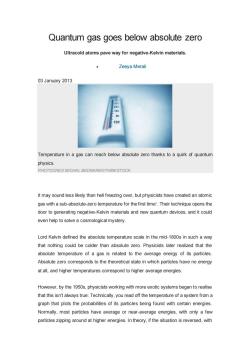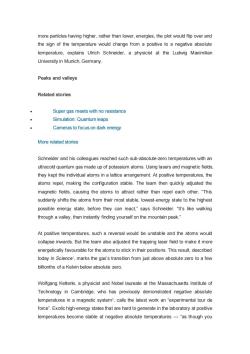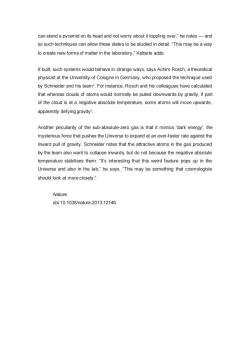《基础化学》课程教学资源(文献资料)Quantum gas goes below absolute zero

Quantum gas goes below absolute zero Ultracold atoms pave way for negative-Kelvin materials Zeeya Merali 03 January 2013 Temperature in a gas can reach below absolute zero thanks to a quirk of quantum physics. PHOTOCREO MICHAL BEDNAREK/THINKSTOCK It may sound less likely than hell freezing over,but physicists have created an atomic gas with a sub-absolute-zero temperature for the first time'.Their technique opens the door to generating negative-Kelvin materials and new quantum devices,and it could even help to solve a cosmological mystery Lord Kelvin defined the absolute temperature scale in the mid-1800s in such a way that nothing could be colder than absolute zero.Physicists later realized that the absolute temperature of a gas is related to the average energy of its particles. Absolute zero corresponds to the theoretical state in which particles have no energy at all,and higher temperatures correspond to higher average energies. However,by the 190s,physicists working with more exotic systems began to realise that this isn't always true:Technically,you read off the temperature of a system from a graph that plots the probabilities of its particles being found with certain energies. Normally,most particles have average or near-average energies,with only a few particles zipping around at higher energies.In theory.if the situation is reversed.with
Quantum gas goes below absolute zero Ultracold atoms pave way for negative-Kelvin materials. • Zeeya Merali 03 January 2013 Temperature in a gas can reach below absolute zero thanks to a quirk of quantum physics. PHOTOCREO MICHAL BEDNAREK/THINKSTOCK It may sound less likely than hell freezing over, but physicists have created an atomic gas with a sub-absolute-zero temperature for the first time1 . Their technique opens the door to generating negative-Kelvin materials and new quantum devices, and it could even help to solve a cosmological mystery. Lord Kelvin defined the absolute temperature scale in the mid-1800s in such a way that nothing could be colder than absolute zero. Physicists later realized that the absolute temperature of a gas is related to the average energy of its particles. Absolute zero corresponds to the theoretical state in which particles have no energy at all, and higher temperatures correspond to higher average energies. However, by the 1950s, physicists working with more exotic systems began to realise that this isn't always true: Technically, you read off the temperature of a system from a graph that plots the probabilities of its particles being found with certain energies. Normally, most particles have average or near-average energies, with only a few particles zipping around at higher energies. In theory, if the situation is reversed, with

more particles having higher,rather than lower,energies,the plot would flip over and the sign of the temperature would change from a positive to a negative absolute temperature,explains Ulrich Schneider,a physicist at the Ludwig Maximilian University in Munich,Germany Peaks and valleys Related stories Super gas meets with no resistance Simulation:Quantum leaps Cameras to focus on dark energy More related stories Schneider and his colleagues reached such sub-absolute-zero temperatures with an ultracold quantum gas made up of potassium atoms.Using lasers and magnetic fields they kept the individual atoms in a lattice arrangement.At positive temperatures.the atoms repel,making the configuration stable.The team then quickly adjusted the magnetic fields,causing the atoms to attract rather than repel each other."This suddenly shifts the atoms from their most stable,lowest-energy state to the highest possible energy state,before they can react,"says Schneider."It's like walking through a valley,then instantly finding yourself on the mountain peak." At positive temperatures,such a reversal would be unstable and the atoms would collapse inwards.But the team also adjusted the trapping laser field to make it more energetically favourable for the atoms to stick in their positions.This result,described today in Science',marks the gas's transition from just above absolute zero to a few billionths of a Kelvin below absolute zero. Wolfgang Ketterle.a physicist and Nobel laureate at the Massachusetts Institute of Technology in Cambridge,who has previously demonstrated negative absolute temperatures in a magnetic system2,calls the latest work an"experimental tour de force.Exotic high-energy states that are hard to generate in the laboratory at positive temperatures become stable at negative absolute temperatures-"as though you
more particles having higher, rather than lower, energies, the plot would flip over and the sign of the temperature would change from a positive to a negative absolute temperature, explains Ulrich Schneider, a physicist at the Ludwig Maximilian University in Munich, Germany. Peaks and valleys Related stories • Super gas meets with no resistance • Simulation: Quantum leaps • Cameras to focus on dark energy More related stories Schneider and his colleagues reached such sub-absolute-zero temperatures with an ultracold quantum gas made up of potassium atoms. Using lasers and magnetic fields, they kept the individual atoms in a lattice arrangement. At positive temperatures, the atoms repel, making the configuration stable. The team then quickly adjusted the magnetic fields, causing the atoms to attract rather than repel each other. “This suddenly shifts the atoms from their most stable, lowest-energy state to the highest possible energy state, before they can react,” says Schneider. “It’s like walking through a valley, then instantly finding yourself on the mountain peak.” At positive temperatures, such a reversal would be unstable and the atoms would collapse inwards. But the team also adjusted the trapping laser field to make it more energetically favourable for the atoms to stick in their positions. This result, described today in Science1 , marks the gas’s transition from just above absolute zero to a few billionths of a Kelvin below absolute zero. Wolfgang Ketterle, a physicist and Nobel laureate at the Massachusetts Institute of Technology in Cambridge, who has previously demonstrated negative absolute temperatures in a magnetic system2 , calls the latest work an “experimental tour de force”. Exotic high-energy states that are hard to generate in the laboratory at positive temperatures become stable at negative absolute temperatures — “as though you

can stand a pyramid on its head and not worry about it toppling over,"he notes-and so such techniques can allow these states to be studied in detail."This may be a way to create new forms of matter in the laboratory,"Ketterle adds. If built,such systems would behave in strange ways,says Achim Rosch,a theoretical physicist at the University of Cologne in Germany,who proposed the technique used by Schneider and his team3.For instance,Rosch and his colleagues have calculated that whereas clouds of atoms would normally be pulled downwards by gravity,if part of the cloud is at a negative absolute temperature,some atoms will move upwards, apparently defying gravity4. Another peculiarity of the sub-absolute-zero gas is that it mimics 'dark energy',the mysterious force that pushes the Universe to expand at an ever-faster rate against the inward pull of gravity.Schneider notes that the attractive atoms in the gas produced by the team also want to collapse inwards,but do not because the negative absolute temperature stabilises them."It's interesting that this weird feature pops up in the Universe and also in the lab,"he says."This may be something that cosmologists should look at more closely." Nature doi:10.1038/nature.2013.12146
can stand a pyramid on its head and not worry about it toppling over,” he notes — and so such techniques can allow these states to be studied in detail. “This may be a way to create new forms of matter in the laboratory,” Ketterle adds. If built, such systems would behave in strange ways, says Achim Rosch, a theoretical physicist at the University of Cologne in Germany, who proposed the technique used by Schneider and his team3 . For instance, Rosch and his colleagues have calculated that whereas clouds of atoms would normally be pulled downwards by gravity, if part of the cloud is at a negative absolute temperature, some atoms will move upwards, apparently defying gravity4 . Another peculiarity of the sub-absolute-zero gas is that it mimics 'dark energy', the mysterious force that pushes the Universe to expand at an ever-faster rate against the inward pull of gravity. Schneider notes that the attractive atoms in the gas produced by the team also want to collapse inwards, but do not because the negative absolute temperature stabilises them. “It’s interesting that this weird feature pops up in the Universe and also in the lab,” he says. “This may be something that cosmologists should look at more closely.” Nature doi:10.1038/nature.2013.12146
按次数下载不扣除下载券;
注册用户24小时内重复下载只扣除一次;
顺序:VIP每日次数-->可用次数-->下载券;
- 《基础化学》课程教学资源(文献资料)合成氨进展——科学家开发出氨合成节能技术.pdf
- 《基础化学》课程教学资源(文献资料)碘与指纹破案.pdf
- 《基础化学》课程教学资源(文献资料)诺贝尔化学奖全书(1901-2001)2/2.pdf
- 《基础化学》课程教学资源(文献资料)诺贝尔化学奖全书(1901-2001)1/2.pdf
- 北京化工大学:《基础化学》课程教学资源(PPT讲稿)酸碱总结.ppt
- 北京化工大学:《基础化学》课程教学资源(实验指导)硫酸亚铁铵的制备及产品质量的分析.pdf
- 北京化工大学:《基础化学》课程教学资源(实验指导)硫酸铜的提纯及产品质量和性能的分析.pdf
- 北京化工大学:《基础化学》课程教学资源(文献资料)价层电子对互斥理论的教材问题探讨.pdf
- 北京化工大学:《基础化学》课程教学资源(实验指导)d区、ds区重要化合物性质.pdf
- 北京化工大学:《基础化学》课程教学资源(实验指导)原电池电动势的测定.pdf
- 北京化工大学:《基础化学》课程教学资源(实验指导)反应活化能的测定.pdf
- 北京化工大学:《基础化学》课程教学资源(实验指导)卤素及其化合物的性质与离子鉴定.pdf
- 北京化工大学:《基础化学》课程教学资源(实验指导)配位化合物的形成和性质.pdf
- 北京化工大学:《基础化学》课程教学资源(实验指导)电离平衡常数的测定.pdf
- 北京化工大学:《基础化学》课程教学资源(实验指导)玻璃仪器的认领和洗涤.pdf
- 北京化工大学:《基础化学》课程教学资源(实验指导)酸碱溶液浓度的比较.pdf
- 北京化工大学:《基础化学》课程教学资源(实验指导)磷酸钠的制备及其总碱量的测定.pdf
- 北京化工大学:《基础化学》课程教学资源(实验指导)混合离子的分离与鉴定.pdf
- 北京化工大学:《基础化学》课程教学资源(实验指导)分析天平的称量练习.pdf
- 北京化工大学:《生化分离工程》课程电子教案(PPT课件)第六章 吸附分离(吸附和离子交换 Adsorption and Ion exchange).ppt
- 北京化工大学:《基础化学》课程教学资源(试卷习题)2012-2013学年第一学期国际班《基础化学》期中考试试卷及参考答案.pdf
- 北京化工大学:《基础化学》课程教学资源(试卷习题)2013-2014学年第一学期《基础化学》期中考试试卷及参考答案.pdf
- 北京化工大学:《基础化学》课程教学资源(PPT课件)第01章 绪论 Fundamental Chemistry(负责人:李保山).pptx
- 北京化工大学:《基础化学》课程教学资源(PPT课件)第02章 物质的聚集状态和溶液.pptx
- 北京化工大学:《基础化学》课程教学资源(PPT课件)第03章 化学热力学基础.pptx
- 北京化工大学:《基础化学》课程教学资源(PPT课件)第04章 化学反应速率及化学平衡.pptx
- 北京化工大学:《基础化学》课程教学资源(PPT课件)第06章 难溶电解质的沉淀溶解平衡.pptx
- 北京化工大学:《基础化学》课程教学资源(PPT课件)第07章 氧化还原反应.pptx
- 北京化工大学:《基础化学》课程教学资源(PPT课件)第08章 原子结构和元素周期率.pptx
- 北京化工大学:《基础化学》课程教学资源(PPT课件)第09章 化学键和分子结构.pptx
- 北京化工大学:《基础化学》课程教学资源(PPT课件)第10章 配位化合物和配位平衡.pptx
- 北京化工大学:《基础化学》课程教学资源(PPT课件)第05章 酸碱平衡(Acid-Base Equilibria).pptx
- 北京化工大学:《基础化学》课程教学资源(PPT课件)第11章 主族元素.pptx
- 北京化工大学:《基础化学》课程教学资源(PPT课件)第12章 过渡元素.pptx
- 北京化工大学:《化学反应工程》课程教学资源(PPT课件讲稿)化学反应工程(第二版,共九章,负责人:郭锴).ppt
- 北京化工大学:《化学反应工程》课程PPT教学课件(英文版)Chemical reaction engineering(2009)Chapter 01-05.ppt
- 北京化工大学:《化学反应工程》课程PPT教学课件(英文版)Chemical reaction engineering(2010)Chapter 17-18.ppt
- 北京化工大学:《化学反应工程》课程PPT教学课件(英文版)Chemical reaction engineering(2010)Chapter 06-10.ppt
- 北京化工大学:《化学反应工程》课程PPT教学课件(英文版)Chemical reaction engineering(2011)Chapter 11-15.ppt
- 北京化工大学:《有机分析》课程教学资源(实验指导,高职,文字版).pdf
